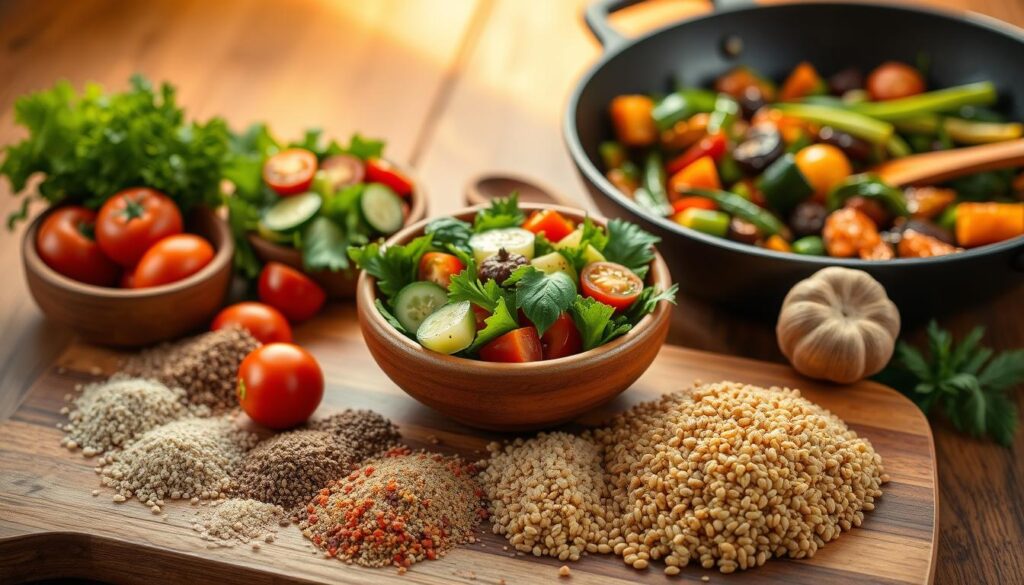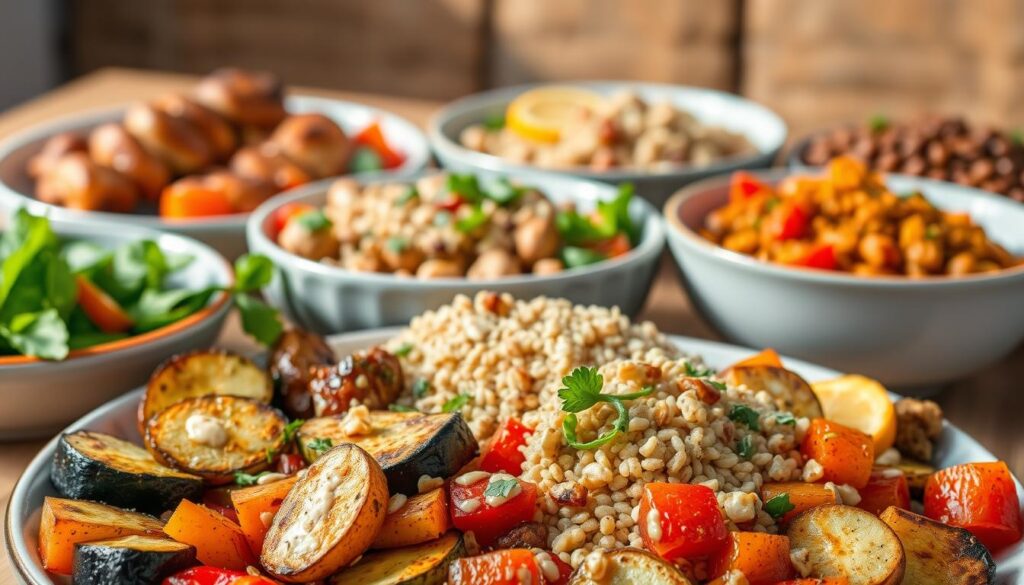What if we told you that vibrant, aromatic dishes could be your ally in achieving healthier body composition? Across the Mediterranean and Arabian Peninsula, traditional culinary practices have perfected the art of combining nutrient-dense ingredients with bold flavors. These time-tested recipes prioritize fresh vegetables, lean proteins, and gut-friendly fermented foods – creating meals that satisfy both palate and nutritional needs.
Regional cooking methods naturally emphasize balance. Chickpea-based hummus provides plant-powered protein, while yogurt-based sauces add probiotics without heavy calories. Spices like turmeric and cumin boost metabolism while reducing the need for excess salt or sugar. This approach to eating doesn’t feel restrictive because it’s rooted in cultural traditions that celebrate nourishment.
We’ll explore how these culinary strategies help regulate portion sizes and stabilize blood sugar. From fiber-rich mezze platters to grilled meats marinated in citrus and herbs, you’ll discover how certain dishes support weight management goals. The secret lies in whole-food combinations that keep meals exciting while promoting satiety.
Key Takeaways
- Traditional recipes use fresh vegetables and legumes as nutritional cornerstones
- Fermented dairy products support gut health and weight management
- Spice blends enhance flavor without empty calories
- Plant-based proteins create satisfying, lower-calorie meals
- Cultural eating patterns emphasize mindful portion control
- Balanced macronutrients prevent energy crashes
Understanding the Nutritional Benefits of Middle Eastern Foods
Regional culinary traditions showcase how simple techniques amplify natural nutrition. Centuries-old practices like clay pot baking and open-flame grilling lock in vitamins while minimizing added oils. These methods create intense flavors through caramelization rather than heavy sauces.
Traditional Cooking Methods and Ingredient Integrity
Fire-roasting vegetables like onions and garlic enhances their sweetness without butter or excess salt. Earthenware dishes cook beans and grains slowly, preserving fiber content. Grilled chicken retains moisture through spice rubs instead of sugary marinades.
- Open-flame cooking reduces reliance on added fats
- Clay pots maintain steady temperatures for even nutrient retention
- Dry spice blends replace calorie-dense sauces
Emphasis on Lean Proteins and Healthy Fats
Meals balance measured amounts of chickpeas with fresh greens and olive oil dressings. Yogurt-based sauces add probiotics without cream’s heavy calories. A typical plate contains:
- 40% vegetables (tomatoes, cucumbers, leafy greens)
- 30% lean proteins (grilled fish, chicken)
- 20% whole grains (bulgur, freekeh)
- 10% healthy fats (olive oil, tahini)
This approach delivers sustained energy through balanced macronutrients. Spices like black pepper and cumin stimulate digestion while reducing salt needs. By prioritizing ingredient quality over complex preparations, these dishes naturally support weight management goals.
Best Middle Eastern foods for weight loss: A Comprehensive List
Discover how centuries-old culinary treasures deliver modern nutritional benefits. Traditional meals balance vibrant spices with smart ingredient pairings, creating dishes that satisfy hunger while aligning with calorie-conscious eating patterns.
Hummus, Labneh, and Baked Falafel
Chickpea-based hummus offers plant protein and fiber in every scoop. Pair it with labneh – a strained yogurt spread rich in probiotics – for a tangy dip that supports gut health. Swap fried falafel for oven-baked versions using minimal oil, retaining crunch without excess fat.
Fattoush Salad, Kebab with Rice, and Seafood Stews
Fattoush combines crisp lettuce, juicy tomatoes, and crunchy cucumbers with toasted pita strips. Grilled chicken or lamb kebabs served over modest rice portions provide lean protein and complex carbs. Seafood stews simmered with tomatoes and spices offer omega-3s in a low-calorie flavor explosion.
These recipes use spices like sumac and paprika to elevate taste without heavy sauces. For balanced meals, pair small amounts of pita bread with bean-based dishes. Adjust ingredient ratios to prioritize vegetables while maintaining authentic flavors.
Incorporating Mediterranean Diet Principles into Our Plate
Many don’t realize how seamlessly Middle Eastern culinary traditions align with Mediterranean eating patterns. Both emphasize fresh, whole ingredients that nourish the body while delighting the senses. This synergy creates meals where every bite delivers both nutritional value and robust flavor.
Heart-Healthy Fats and the Role of Olive Oil
Extra virgin olive oil forms the foundation of countless recipes. Its monounsaturated fats support heart health and help regulate cholesterol. Drizzled over chopped tomatoes and cucumbers, it transforms simple salads into nutrient-packed dishes.
Traditional meals balance fats intelligently. Labneh replaces heavy creams in sauces, offering probiotics alongside creamy textures. Garlic and mint elevate grain-based dishes like bulgur pilaf without relying on excess salt.
| Ingredient | Mediterranean Use | Middle Eastern Use | Key Benefit |
|---|---|---|---|
| Olive Oil | Salad dressings | Dipping sauces | Reduces inflammation |
| Tomatoes | Fresh salads | Stews & mezze | Rich in lycopene |
| Whole Grains | Pasta alternatives | Freekeh bowls | Sustained energy |
Spices like sumac add zing to grilled chicken, reducing the need for calorie-dense marinades. Even bread becomes a tool for balance when paired with fiber-rich dips instead of butter. These principles create meals that satisfy hunger while supporting metabolic health.
By focusing on ingredient quality over restrictive rules, this approach fosters lasting dietary habits. A plate featuring 50% vegetables, 25% lean proteins, and 25% whole grains naturally aligns with weight management goals – no calorie counting required.
Smart Meal Planning for a Middle Eastern-Inspired Weight Loss Journey
Effective meal planning transforms cultural flavors into sustainable health strategies. By focusing on whole ingredients and intentional combinations, traditional dishes become powerful tools for managing calorie intake while maximizing nutrition.
Creating Balanced, Nutrient-Rich Meals
Start with a base of fiber-rich veggies like roasted eggplant or spinach. Add lean proteins such as grilled chicken marinated in lemon and garlic. Complete your bowl with a quarter-cup of whole grains like bulgur or freekeh for sustained energy.
Incorporate healthy fats strategically:
- Swap frying oils for olive oil dressings
- Use walnuts as salad toppings instead of croutons
- Pair hummus with veggie sticks rather than pita bread
Portion Control and Recipe Tweaks
Traditional recipes adapt beautifully to modern dietary needs. Bake falafel instead of frying to cut fat content by 40%. Use Greek yogurt instead of tahini in dressings for extra protein. Our kofta kebab meal prep guide shows how spices can replace salt in meat dishes.
Three simple adjustments enhance any diet:
- Serve salads as main dishes with added beans
- Use small plates for grain-based sides
- Roast vegetables to intensify natural sweetness
These modifications preserve authentic taste while aligning with calorie-conscious goals. Remember: successful meal planning relies on balancing tradition with smart nutritional choices.
Exploring Low-Carb and Whole Grain Alternatives in Middle Eastern Cuisines
Creative adaptations let enthusiasts enjoy rich flavors while meeting modern dietary needs. Many classic dishes become carb-conscious through simple ingredient swaps that maintain cultural authenticity.
Reimagining Staple Ingredients
Riced cauliflower stands in for traditional grains, absorbing spices like turmeric and sumac beautifully. Lupini beans replace bread in mezze spreads, offering plant-based protein with 75% fewer carbs than pita. Even stuffed grape leaves get a makeover using minced mushrooms instead of rice.
Legumes form the foundation of smart substitutions. Chickpea flour creates crispy falafel with 40% fewer net carbs than wheat-based versions. Black bean hummus delivers extra fiber while keeping the creamy texture everyone loves.
Spice blends become essential for flavor enhancement. A dash of smoked paprika transforms roasted zucchini into a satisfying rice alternative. Olive oil drizzle adds richness to veggie-based tabbouleh made with chopped kale and parsley.
These modifications align with various diet plans without sacrificing cultural identity. A typical adjusted meal might feature:
- Grilled chicken marinated in garlic and lemon
- Spiralized beet “couscous” with mint
- Roasted red pepper dip using Greek yogurt base
We encourage experimenting with textures – crushed walnuts mimic bulgur’s bite in salads. Remember: successful carb reduction relies on bold flavors from quality olive oil and fresh herbs. Start with one substitution per meal, then expand your repertoire as tastes adapt.
Conclusion
Embracing time-honored culinary traditions offers more than just taste—it’s a pathway to sustainable wellness. Traditional meals combine garlic-infused sauces with crisp cucumbers and roasted tomatoes, delivering nutrition-packed dishes that naturally support weight goals. Research confirms Mediterranean diet principles—emphasizing olive oil, fresh veggies, and lean meats—enhance metabolic health while keeping meals satisfying.
Smart cooking techniques transform simple ingredients. Grilled lamb gains depth from mint rubs, while baked fish gets zest from lemon and spices. Walnuts add crunch to grain bowls without heavy sauces. These methods preserve health benefits while controlling calories.
We invite you to explore labneh dips, chicken kebabs, and veggie-stuffed stews. Adjust portion sizes using small plates, or swap rice for riced cauliflower in pilafs. Every flavorful bite proves nourishing foods don’t require sacrifice.
Start your journey today: roast eggplant with garlic, toss salads with olive oil, or marinate chicken in turmeric. Share your creations using #FlavorForwardNutrition—let’s build a community celebrating delicious, intentional eating.




